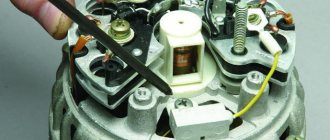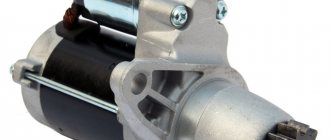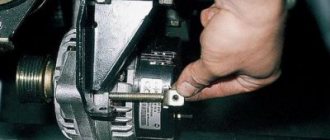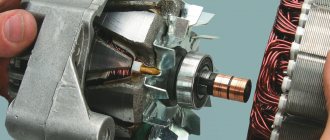Many car owners are faced with a situation where, after starting the engine, the on-board computer or one of the devices begins to show that the battery is being recharged.
The consequences of this situation are very different and depend on how much the voltage in the on-board network exceeds the nominal one.
Slightly increased parameters will only negatively affect the battery (boiling of the electrolyte followed by its evaporation), but if the voltage coming from the generator greatly exceeds the norm, then electrical consumers may fail.
In any case, overcharging is a phenomenon that must be eliminated, otherwise it will not have the best effect on the service life of the battery and electrical appliances.
Next we will look at why the generator produces a higher voltage of 16, 17 volts into the car’s on-board network, the reason why U jumps and how to eliminate them.
What is battery recharging
Essentially, this is a charge above the norm, and in order to understand the topic in more detail, you must first understand what the norm is. The standard voltage at the terminals of a fully charged battery is on average 12.7V. When starting the engine, this figure drops, as a significant amount of electricity is released.
After the start, the machine’s hog network powers the generator, providing a voltage of about 14.5V. Current flows to the battery electrode plates, triggering reduction processes in the electrolyte - thus charging the battery.
If this process occurs at increased voltage (more than 20V) for a long time, the battery electrode grids begin to heat up, and the water in the jars evaporates and bubbles, which creates boiling. The concentration of sulfuric acid in the electrolyte increases, that is, its density increases.
During boiling, water breaks down into oxygen and hydrogen, and the resulting excess gas does not have time to be removed. At this stage, overcharging is especially dangerous - destruction of the battery case and even an explosion are possible.
Checking the electrolyte level in the battery.
The next step, after checking and eliminating the self-discharge of the car battery, is to check the electrolyte level in it. Of course, this only applies to serviceable batteries.
The electrolyte level is checked using a special glass level tube, and the electrolyte level should be within 10-12 mm above the battery plates.
A level tube is an ordinary glass tube with divisions in millimeters marked on it. In order to measure the electrolyte level, you need to place the tube in the battery filler hole until it comes into contact with the separator mesh, pinch the upper end of the tube with your finger and pull out the tube. The upper electrolyte level in the level tube will correspond to the electrolyte level in the battery.
Basically, a low level is a consequence of the electrolyte “boiling away”; in this case, the electrolyte level is adjusted by adding distilled water.
Topping up the battery directly with electrolyte is done only when you are sure that the drop in level was due to a spill of electrolyte from the battery.
Before proceeding with further testing of the battery, it is necessary to assess the degree of its charge and carry out further testing of the battery after it is fully charged.
The degree of charge can be determined in two ways: either measure the density of the electrolyte in the battery, or measure the voltage on the battery.
Which cars are affected by the problem?
Naturally, the probability of the battery receiving an excess charge on new foreign cars is significantly lower than on products with a significant mileage from the domestic automobile industry. However, there are a number of models where overcharging is considered a common problem.
We are talking about classic VAZ cars. Among the “classics”, this malfunction most often occurs on the “six” (VAZ 2106).
Trucks and some UAZ models are equipped with on-board voltage sensors and sometimes these sensors begin to signal an increase in the charging current between the generator and the battery (18V or more). This is not normal and may lead to rapid overcharging. However, often the problem is in the sensors themselves, which show incorrect information.
How many volts should the generator produce?
The key parameter is voltage. The operating voltage of the Lada Priora generator is 14 Volts: this voltage should be produced by the generator on the Priora without and with air conditioning. A deviation from the nominal value to a lesser extent will lead to unstable operation or failure of the electrics, deterioration of performance, and to a greater extent it can cause burnout of circuits and blocks. If abnormalities occur (low current or too high), the device needs to be diagnosed and replaced, if necessary.
The second parameter is the current strength. On Priors there are generators with 115 amperes, 90, 80, etc. This depends on the year of manufacture of the car, body type and configuration. Models with air conditioning have higher power.
Photo source: https://primahim.ru/p361170614-generator-2170-115a.html
The generator is an electromechanical device, and the causes of its failures lie in both electrical and mechanical components. Common faults:
- damaged or worn pulley;
- wear of slip rings or brushes;
- a failed relay (regulator) of the voltage of the Priora generator;
- destruction of bearings;
- short circuit on the stator winding;
- physical damage to wires;
- diode bridge problems.
It should be borne in mind that voltage problems do not always indicate a breakdown of the generator itself. The reason may lie in the battery, wiring and other components.
How to detect overcharge
You can accurately determine that recharging is in progress using a multimeter. For this:
- Set the multimeter to DC mode at approximately 20V;
- We connect the contacts to the battery terminals (black wire for minus, red for plus);
- With the engine not running, a fully charged battery produces a voltage of 12.7V;
- We start the engine;
- If the generator is working properly, the snout is working and there are no problems in the on-board network, the multimeter should show 14.5V (+- 0.5V).
An overcharged battery is detected by external signs (oxidation of the terminals, electrolyte leaks on the case) or by data from the on-board computer. If your car does not have a built-in BC, you can purchase an external one.
You should pay attention to the interior lighting and the dashboard light. One of the first signs of overcharging is excessive brightness of the on-board equipment lamps.
First maintenance is an important point for the battery.
Many car battery malfunctions are the result of improper maintenance, and in particular the very first one. To prevent battery malfunctions from causing constant stress and additional material costs, the first maintenance must be performed correctly:
- Cleaning the battery case from dirt, oil, electrolyte.
- Checking and tightening the battery fasteners in the engine compartment.
- Gently but thoroughly clean the gas outlet holes in the plugs. To do this, it is convenient to use a toothpick or a thick needle.
- Checking the condition of the wire tips going to the battery terminals, assessing the reliability of their fastening. If signs of oxidation are detected on the terminals, they are thoroughly cleaned with a wire brush and sandpaper.
- The electrolyte level is controlled using a glass tube. If topping is necessary, use only distilled water.
Important! During the second and subsequent checks, the above is added to the measurement of electrolyte density and its correction.
What can constant overcharging lead to?
- During recharging, the electrolyte boils, and it partially flows out through the gas outlet holes and plugs of the cans. If the process continues long enough, the leaked sulfuric acid solution will end up on the radiator, wires, cooling hoses and body. The acid concentration is not high, but over time it will corrode some of the above.
- With a slight overcharge, the electrolyte falls on the battery case in the form of condensation on the terminals, causing them to oxidize and become covered with a green coating.
- Evaporation of the electrolyte leads to a decrease in its level in the banks, some of the electrodes are exposed, the plates overheat and the active mass falls off from them. This threatens to short circuit the cans and cause the battery to fail completely.
- Recharging at the final stage is accompanied by significant overheating, during which the electrolyte water breaks down into oxygen and hydrogen. The resulting mixture of gases may explode, with acid ending up in the engine compartment.
- Fuses and light bulbs on the dashboard and in the cabin blow out, other on-board electronics stop working (the voltage limit they can withstand does not exceed 17V). In some cases, the on-board network wires may melt and catch fire.
AGM batteries are especially sensitive to overcharging. The electrodes of such batteries are separated by matte glass separators. When heated, the electrolyte quickly evaporates from the porous glass fiber, leaving the plates dry. As a result, the active mixture crumbles and the battery becomes unusable.
Gel batteries suffer no less. With constant recharging, the gel can settle, exposing the upper part of the plates, which immediately close. After this, the battery will immediately become unusable.
Battery terminal oxidation
Further, the electrolyte level drops, the lead plates are exposed, and still charging continues! Then, they will heat up, which has a very detrimental effect on them and you will experience “shattering”; the banks may also short out or the battery will break off altogether.
And don’t think that this is just evaporation of the electrolyte, yes it evaporates, but this is if you delve into the process of explosive gases (oxygen and hydrogen), and as a result, the battery itself can explode without any problems, moreover, with such force that you don’t think it’s funny it will be, because everything under the hood will be in acid. And if the power supply explodes, then some fuses may not be able to withstand it, because they are not designed for 17 Volts.
Causes and solutions
Excessive battery charge occurs for the following reasons:
- Faulty generator shaft . We are talking about a situation where the regulator is working, but does not perform its functions correctly. The generator snout does not allow the onboard voltage to exceed 14.5V. A defective or faulty device supplies slightly higher currents to the vehicle network, which leads to a stable but not critical overcharge, since the voltage, as a rule, is slightly higher than the standard one.
- Non-working generator face . In such cases, electricity is supplied to the battery directly from the generator without any restrictions, and the voltage can exceed 24V, which as a result causes a significant overcharging of the battery.
- Faulty generator . If the diode bridge is damaged, the winding or armature breaks down on the housing, part of the current will flow past the snout, leading to overcharging.
- Poor contact in the circuit . A working relay perceives the resistance created by a poor contact as an increased load on the vehicle network. Trying to compensate, the regulator passes more voltage into the network, as a result the battery is recharged.
- Incorrect charging from the charger . Some older chargers are manually configured. An incorrectly selected mode leads to overcharging.
Important! You should not ignore partial failure of the generator, since the faulty part may sooner or later become completely inoperable.
The battery is sometimes deliberately overcharged in an attempt to restore functionality. This is done to increase the density of the electrolyte. Under high voltage, the temperature rises, boiling begins, water evaporates and the concentration of sulfuric acid increases.
Is it possible to charge a full battery?
Reasons for discharging the VAZ 2110 battery
Many car enthusiasts know the phenomenon of battery overcharging. It occurs when, for some reason, the voltage regulator starts to work incorrectly, so the voltage at the generator output exceeds 14.5 Volts. The optimal voltage of a fully charged battery is 14 Volts. When the voltage difference between the generator and the battery exceeds one volt, the latter begins to absorb additional energy, which leads to boiling and evaporation of the electrolyte, as well as destruction of the lead plates. As a result, the electrolyte level first decreases, then the battery capacity decreases. After a short time (depending on the generator voltage), the drop in capacity becomes irreversible and cannot be restored by adding distilled water.
If the generator voltage regulator is working normally, then the voltage is maintained at 14 - 14.5 Volts, due to which the battery avoids overcharging. All this fully applies to stationary battery charging, which is carried out using a special charger. If the voltage at the output of the device does not exceed 14.5 Volts, then the battery will take the amount of electricity that is necessary to change the density of the electrolyte. When the voltage of the generator and the charger are equal, the rate of absorption of electricity will drop so much that further charging becomes meaningless. Even if the battery sits on the charger for two days, its capacity and charge will not change. If the voltage at the charger output exceeds 14.5 - 15 Volts, then overcharging will begin, which will lead to a decrease in battery capacity.
If you are using a charger that displays charging current but not voltage, consider the following. The charging current of a fully charged battery should not exceed 1 percent of its capacity. As soon as the charging current has dropped to 1-2 percent, it is necessary to disconnect the battery from the charger to avoid damaging it. Do not charge the battery from a charger without a voltage indicator if the charging current is less than 5 percent of capacity. This will extend the life of the battery and protect it from premature damage.
How to protect your battery from overcharging
To charge the battery outside the car, you should use modern chargers with automatic voltage regulation. The functionality of budget devices is quite modest, but it is quite enough to charge the battery without any negative consequences.
The simplest and most effective way to protect a car battery from overcharging by a generator is to use an on-board computer. In some cars, the BC is installed from the factory, but if there is no built-in one, you can always purchase an external one. In addition to the battery status, the on-board computer displays a lot of other useful information.
What kind of charging should go to the battery from the generator?
It is traditionally believed that 13.5-14.5V should be supplied by the generator to the battery and this is absolutely enough to replenish the battery costs.
It is worth considering that using a battery with a higher power in a car than the manufacturer recommends also requires the installation of a more productive generating device.
It is necessary to take into account the load that the generator must withstand - it is calculated based on the maximum indicators of all electrical appliances and car systems.
Do not forget that the charging current from the energy-generating device will allow you to start the car in the cold season. In order to avoid problems with starting the car, we recommend purchasing generating equipment, the charge current of which will be approximately 10% of the capacity of the power source. That is, a battery of 100 A/h requires a generator that can produce 10A. Please note that for many cars, 100 amp equipment will operate at its maximum capacity, because the power consumption of the automotive system is in the region of 80 amps. Therefore, the choice of a source generating energy must take into account both the battery capacity and network consumption.
Common battery problems:
- short circuit of battery electrodes/plates;
- mechanical or chemical damage to the battery plates;
- violation of the tightness of battery cans - cracks in the battery case as a result of impacts or improper installation;
- chemical oxidation of the battery terminals. The main causes of these malfunctions are:
- gross violations of operating rules;
- expiration of the product's service life;
- various manufacturing defects.
It is very useful for a motorist to know the main causes of generator malfunctions , how to eliminate them, as well as preventive measures to prevent breakdowns.
All generators are divided into alternating and direct current generators. Modern passenger vehicles are equipped with alternating current generators with a built-in diode bridge (rectifier). The latter is necessary to convert current into direct current, on which the vehicle's electrical consumers operate. The rectifier, as a rule, is located in the cover or housing of the generator and is integral with the latter.
All electrical appliances of the car are designed for a strictly defined operating voltage range. As a rule, operating voltages are in the range of 13.8–14.7 V. Due to the fact that the generator is “tied” with a belt to the engine crankshaft, it will work differently . It is for smoothing and regulating the output current that the relay-voltage regulator is designed, playing the role of a stabilizer and preventing both surges and dips in the operating voltage. Modern generators are equipped with built-in integrated voltage regulators, colloquially referred to as “chocolate” or “tablet”.
It is already clear that any generator is a rather complex unit, extremely important for any car.
Battery charging circuit
For a general understanding of the reasons for overcharging, first consider the battery charging circuit diagram. And although it is structurally different on different cars, the general principle of construction is the same.
This circuit includes:
- Generator;
- Rectifier block (diode bridge);
- Relay regulator;
- Fuse box;
- Egnition lock;
- Charge indicator lamp;
- Battery
The recharging system works using the example of the VAZ 2106 and other cars from the VAZ classic series as follows: after starting the power plant, by means of a belt drive, the crankshaft begins to rotate the generator rotor, as a result of which this unit begins to generate electricity.
Types of generator faults
Due to the fact that any generator is an electromechanical device, there will be two types of faults - mechanical and electrical.
The first includes the destruction of fasteners, housing, malfunction of bearings, pressure springs, belt drive and other failures not related to the electrical part.
Electrical faults include winding breaks, diode bridge faults, brush burnout/wear, turn-to-turn short circuits, breakdowns, rotor beating, and relay-regulator faults.
Often, symptoms that indicate characteristics of a faulty generator can also appear as a result of completely different problems. As an example, poor contact in the fuse socket of the generator field winding circuit will indicate a generator malfunction. The same suspicion may arise due to burnt contacts in the ignition switch housing. Also, the constant lighting of the generator malfunction indicator lamp can be caused by a breakdown of the relay; the blinking of this switching lamp may indicate a generator malfunction.
The main signs of a faulty generator:
- When the engine is running, the battery discharge warning lamp flashes (or stays on continuously).
- Discharging or overcharging (boiling) of the battery.
- Dim car headlights, a rattling or quiet beep when the engine is running.
- Significant change in headlight brightness with increasing speed. This may be acceptable when increasing the speed (re-throttle) from idle, but the headlights, having lit up brightly, should not increase their brightness any further, remaining at the same intensity.
- Extraneous sounds (howling, squeaking) coming from the generator.
It is necessary to regularly monitor the tension and general condition of the drive belt. In case of cracks and delaminations, immediate replacement is necessary.
Other causes of low voltage
A small potential difference in the system is not always associated with a breakdown of the generator or a bad battery. If the diagnosis of these elements does not reveal any problems, then you should pay attention to the following:
- condition of the battery terminals - connection density and oxidation;
- electrical wiring problems - oxidation, violation of its integrity;
- output contacts to electrical appliances;
- correctly selected energy consumers.
Each contact must be tightly adjacent and intact, that is, there must be no formations (for example, sulfation) that will disrupt the flow of current. Incorrect connection of contacts leads to accelerated battery discharge even when the car is not running.
Generator repair kits
To eliminate these generator malfunctions, you will need to carry out repairs. When you start searching for a generator repair kit on the Internet, you should prepare for disappointment - the kits offered usually contain washers, bolts and nuts. And sometimes the generator can only be restored to functionality by replacing brushes, a diode bridge, a regulator... Therefore, the brave person who decides to repair it makes an individual repair kit from those parts that fit his generator. It looks something like this, as shown in the table below, using the example of a pair of generators for a VAZ 2110 and a Ford Focus 2.
| Generator KZATE 9402.3701-03 | ||
| Detail | Catalog number | Price, rub.) |
| Brushes | 1127014022 | 105 |
| Voltage regulator | 844.3702 | 580 |
| Diode bridge | BVO4-105-01 | 500 |
| Bearings | 6303 and 6203 | 345 |
| Generator Bosch 0 986 041 850 | ||
| Detail | Catalog number | Price, rub.) |
| Brushes | 140371 | 30 |
| Brush holder | 235607 | 245 |
| Voltage regulator | IN6601 | 1020 |
| Diode bridge | INR431 | 1400 |
| Bearings | 140084 and 140093 | 140/200 rubles |
What generator is installed on the VAZ 2114?
Having figured out what voltage the generator on the VAZ 2114 should produce, it’s worth understanding what kind of device produces it. This domestic hatchback is equipped with a three-phase generator type 94.3701 from the factory. It consists of a stationary winding or stator, a rotor, rotor bearings, an impeller, and a pulley for putting on a belt. It also has a diode bridge or rectifier, a voltage regulator and a housing.
Russian-made devices of the KZATE brand were installed on the car from the factory. Also, on some cars of recent years of production you can find standard German Bosch. Despite the fact that domestic generators, with proper care, can be used for a relatively long time, foreign-made parts are considered more reliable. Therefore, when replacing, many owners buy products from this or another foreign brand. In addition, sometimes more powerful generators are installed. They are purchased, for example, by car audio enthusiasts, since the factory ones are not designed for such a heavy load.Troubleshooting
On modern cars, using the “old-fashioned” diagnostic method by removing it from the battery terminal can lead to serious damage to many of the car’s electronic systems. Significant voltage drops in the vehicle's on-board network can damage almost all on-board electronics. That is why modern generators are always checked only by measuring the voltage in the network or diagnosing the removed unit itself on a special stand. First, the voltage at the battery terminals is measured, the engine is started, and readings are taken while the engine is running. Before starting, the voltage should be about 12 V, after starting - from 13.8 to 14.7 V. A deviation towards the higher side indicates that you are “overcharging”, which implies a malfunction of the relay regulator, towards a lower level - that no current is flowing. The absence of recharging current indicates a malfunction of the generator or circuits.
Most frequently asked questions
Will the battery be recharged if a higher power generator is installed?
No, because regardless of the power of the generator, the voltage at its output is limited by the relay regulator to the maximum permissible for the battery.
Does the diameter of the power wires affect recharge?
The increased diameter of the power wires in itself cannot cause the battery to overcharge. However, replacing damaged or poorly connected wiring may increase the charging voltage if the alternator is faulty.
How to properly connect the second (gel) battery so that there is no overcharging?
To prevent overcharging of the gel battery, it must be connected through an isolation device. To prevent overvoltage, it is advisable to use a limiter terminal or another voltage controller (for example, voltage control relay 362.3787-04).
The generator recharges the battery, is it possible to drive home with the battery removed?
If the relay regulator is broken, you cannot disconnect the battery at all. Reducing the load will raise the already high voltage from the generator, which can cause lamps and on-board electronics to fail. Therefore, when recharging the car instead of the battery, turn off the generator.
Do I need to change the electrolyte after recharging the battery for a long time?
The electrolyte in the battery is changed only after the battery has been refurbished. Replacing the electrolyte that has become cloudy due to crumbling plates by itself does not solve the problem. If the electrolyte is clean, but its level is low, you need to add distilled water.
How long can a battery be charged to increase the density of the electrolyte (evaporate water)?
Time limits are individual and depend on the initial density. The main thing is not to exceed the charge current of 1–2 A and wait until the electrolyte density reaches 1.25–1.28 g/cm³.
Self-test of the generator
The easiest way is to check the fuse. If it is in good condition, the generator and its location are inspected. The free rotation of the rotor, the integrity of the belt, wires, and housing are checked. If nothing arouses suspicion, the brushes and slip rings are checked. During operation, the brushes inevitably wear out, they can become jammed, skewed, and the grooves of the slip rings become clogged with graphite dust. A clear sign of this is excessive sparking.
There are frequent cases of complete wear or failure of both bearings and stator failure.
The most common mechanical problem with a generator is bearing wear. A sign of this malfunction is a howling or whistling sound when the unit is operating. Of course, the bearings must be replaced immediately, after first inspecting the seats. Loose drive belt tension can also cause poor generator performance. One of the signs may be a high-pitched whistle from under the hood when the car accelerates or accelerates.
To check the rotor field winding for short-circuited turns or breaks, you need to connect a multimeter, switched to resistance measurement mode, to both contact rings of the generator. Normal resistance is from 1.8 to 5 ohms. The readings below indicate the presence of a short circuit in the turns; above – direct winding break.
To check the stator windings for ground fault, they need to be disconnected from the rectifier unit. If the resistance readings given by the multimeter are infinitely large, there is no doubt that there is no contact between the stator windings and the housing (“ground”).
To check the diodes in the rectifier block, use a multimeter (after completely disconnecting it from the stator windings). The test mode is “diode test”. The positive probe is connected to the plus or minus of the rectifier, and the negative probe is connected to the phase terminal. After this, the probes are swapped. If the values of the multimeter readings differ greatly from the previous ones, the diode is working; if they do not differ, it is faulty. Another sign indicating the imminent “death” of the generator diode bridge is oxidation of the contacts, and the reason for this is overheating of the radiator.
How to check the operation of the generator
The battery in a car is an important element of the system, which is responsible for providing the car’s on-board network with electricity. The generator is used to charge the battery while it is active. Unstable operation of a device generating electricity causes a voltage drop in the network and failure to restore the capacity of the power source.
Normal generator performance means timely and complete replenishment of the battery charge level, which decreases under load. Checking the battery charge level from the generator is simple and can be done by the car owner himself.
Diagnostics of an automotive energy-generating device includes a visual inspection of the unit, its elements and related parts, as well as voltage and current measurements. At least twice a year, you should check the tension of the drive belt, excessive weakening of which leads to a decrease in the performance of the generator, and sometimes can lead to breakdown of the device. Once a year, you can check equipment elements - fasteners, diode bridge, voltage regulator and others. Timely maintenance of the battery will also guarantee the absence of problems - cleaning the terminals, adding distilled water.
Diagnostics of indicators such as voltage, current, resistance are also necessary twice a year. To carry it out, you will need special devices - a voltmeter, multimeter or load fork.
Repair and troubleshooting
All mechanical problems are eliminated by replacing faulty components and parts (brushes, belt, bearings, etc.) with new or serviceable ones. Older generator models often require grinding of slip rings. Drive belts are replaced due to wear, maximum stretching or expiration of service life. Damaged rotor or stator windings are currently being replaced with new assembled ones. Although rewinding is common among auto repair services, it is becoming less and less common - it is expensive and impractical.
But all electrical problems with the generator need to be solved by checking both other elements of the circuit (in particular the battery), and directly its parts and output voltage. One of the common problems that car owners have to deal with is overcharging , or, conversely, low voltage of the generator . Checking and replacing the voltage regulator or diode bridge will help eliminate the first malfunction, but low voltage output will be a little more difficult to deal with. There may be several reasons why the generator produces low voltage:
- increased load on the on-board network by consumers;
- breakdown of one of the diodes on the diode bridge;
- failure of the voltage regulator;
- slipping of the poly V-belt (due to low tension)
- poor contact of the ground wire on the generator;
- short circuit;
- drained battery.
Greetings, forum members! The problem is this: at idle the charge is 13.6-14 V. At 16 V, the high beams, heaters, and music are on. After dropping the speed, the voltage at idle remains 15.8 V. The diode bridge is intact, I have already changed two generators, before installing them on the car, I checked them on a stand, both produced 14.3 V. They are obviously both in good working order. I installed a 3-level voltage regulator from a VAZ-2110. The situation has changed: at idle it consistently produces 13.6 V (on the regulator it was set to 13.6 V), but at speed it now produces 15.2 V with all consumers turned on. Why Is the tension rising?
Comments 56
What is the voltage on the thin wire?
What kind of thin wire is this?
There are two wires on the generator, a thick one and a thin one for pp
Problems in the wires, it should be the same as on the thick one, if the pp is on the generator
1 Poor contact with ground, incl. due to burning of contacts in the mass switch, this effect can occur. This must be excluded first. An ohmmeter will not help here; what matters is the contact area and its throughput. 2 Measure the voltage at + battery and + regulator relay (do not start the engine and do not change the negative point when measuring). If the voltage is different, then there are losses along the chain and you need to check the ignition switch, etc. An ohmmeter will help you. But before you rush into search, lay a 2.5 mm2 wire straight from + battery to + regulator relay, start it and check the on-board voltage, if everything is normal, then this is the reason.
The voltage on the battery and the relay is different. On the battery 12.9 V, on the relay 9.8 V.
Great! I mean, everything is bad, but the reason has been found (perhaps one of the reasons). Run the wire straight from + battery to + RR and start it and see the effect. The voltage should stabilize. Write about the result).
I installed the relay according to the diagram and forgot about recharging.
Which is what was required))).
The same circuit. Also 15.1 15.2. but what I noticed was that I drove longer and the voltage drops to 13.7. battery, but I’ll do it while it’s warm.
The battery is new. I also installed another battery. Everything is unchanged.
If you measure it with a voltmeter, specifically at the battery terminals with the engine running, how much does it show?
At idle 13.6V, at speed with lights, music, stoves on 15-15.2V.
And the on-board voltmeter shows the same?
It shows more. I already turned it off too.
Then we have a difference, for me it shows more at idle.
And now I have the same thing. I'll follow the topic until I get to my point. There is a suspicion that the regulator receives a low voltage and it raises it at the output. Somewhere the contact is acting up I think. I also took the generator to the stand and everything was fine with it.
I'll try to look at the ignition switch today, maybe there is a bad contact there.
And now I have the same thing. I'll follow the topic until I get to my point. There is a suspicion that the regulator receives a low voltage and it raises it at the output. Somewhere the contact is acting up I think. I also took the generator to the stand and everything was fine with it.
The engine does not pull: the main reasons for the decrease in engine power
So, if no other symptoms other than loss of traction are detected, then you immediately need to pay attention to the quality of the fuel, the proper functioning of the ignition and power systems. As practice shows, more than half of the cases of reduced efficiency from internal combustion engines are associated with fuel
The engine does not turn on due to the fact that the tank may be filled with low-quality or unsuitable fuel for this type of engine (for example, 92-grade gasoline instead of 95-grade gasoline)
As practice shows, more than half of the cases of reduced efficiency from internal combustion engines are associated with fuel. The engine does not turn on due to the fact that the tank may be filled with low-quality or unsuitable fuel for this type of engine (for example, 92-grade gasoline instead of 95-grade gasoline).
Typically, such manipulations are necessary when, parallel to the loss of traction, unstable operation of the internal combustion engine is noted, the speed jumps or floats at idle and under load, the engine does not start easily, the “check” light is on the panel, etc.
Also, owners of gasoline engines can independently determine the quality of gasoline by the spark plugs and their appearance. To check the spark plugs you need to unscrew them from the engine. A disruption in the combustion process of the fuel-air mixture in the cylinders, as well as the presence of impurities in the fuel, can be identified by soot on the spark plugs and its color.
For example, if the fuel contains a lot of third-party metal-containing additives and additives, then the skirt and electrodes may become covered with reddish soot (brick-colored). Black soot will indicate that the fuel is not burning properly, etc. In any case, malfunctions in the combustion process of the working mixture lead to the fact that the engine stops pulling.
The next step in diagnosis is checking the spark plugs. A decrease in the efficiency of these elements is also accompanied by a decrease in the power of the power unit.
This is especially noticeable during sharp accelerations, and when the car is already moving at high speed. In other words, the motor has no “reserve” left for further acceleration.
The candles may be dirty, and it is also possible that their life has come to an end. To fix this problem, you can clean the spark plugs or immediately replace the entire set with a new one.
If everything is in order with the spark plugs, then you need to check the condition of the fuel and air filters. In the first case, insufficient throughput can lead to the fact that the required amount of fuel is not supplied to the cylinders to prepare the so-called “power” mixture.
Do-it-yourself troubleshooting
It is better to start diagnosing VAZ 2114 cars with the most accessible and simple causes of possible problems. It is necessary to adjust the tension of the drive belt and ensure that its brush mechanism is in good condition (including the general condition of the holder).
Tighten the fastenings of the power wires. Concerns about dismantling the entire assembly and revising it should be carried out after all previous options did not produce results.
As in the previous case, you need to start from a simple case to a complex one:
- checking the status of the regulator;
- Make sure once again that there is less than 14.6 V on a cold engine;
- turn off the engine, disconnect the battery terminals;
- disconnect all electrical wiring from the unit being repaired;
- remove the plastic protection of the electrical contact unit;
- remove the wiring block and unscrew the 2 mounting screws;
- remove the regulator;
- make sure that the brushes and brush holder are in good condition, otherwise replace them;
- Using a battery, a 12 V light bulb and 2 AA batteries, check the functionality of the tablet. By applying alternately 12 V and then 15 V, make sure that the light on the brushes is on;
- otherwise, replace the “tablet” with a similar model;
- checking and replacing the diode bridge (horseshoe), for this purpose it is better to remove the generator from the car;
- Using a spanner or socket wrench, unscrew the 3rd fastening nuts and the 2nd hooks securing the spacer bushings;
- disconnect the supply wires (soldering) and remove the “horseshoe”;
- in this state, you can check the suitability of all 6 power and 3 additional diodes, if you have a multimeter and certain electrician skills;
- replace faulty diodes or purchase a new unit entirely;
- at the same time you can check the windings of the generator itself for breakdown;
- replacing it without removing the protection;
- choose the right tool - various 13 mm wrenches. and 10 mm, socket heads sizes 13,17 and 19 with ratchet, lever (mount);
- disconnect the battery;
- loosen the excessive tension on the drive belt, remove it along with the adjustment unit;
- remove the battery connection wire;
- Using a “13” head, unscrew both bolts securing the adjusting bracket to the car block, one of them is longer than the other;
- after that, turning the generator clockwise, you can remove its axis of attachment to the bracket;
- You should not miss the opportunity to check the condition of the front bearing assembly;
Having thus removed the electrical installation, you can begin to solve all both mechanical and electrical problems associated with the performance of this unit. However, it should be assumed that if replacing the “tablet” and adjusting the tension belt are operations quite accessible to the average car enthusiast, then it is still better to do the manipulations in specialized car services.
Main reasons with engines of other cars
Next, we will go through other cars, and we will indicate the most frequently occurring problems that lead to a drop in power.
So, on a Mitsubishi Lancer 9, the problem most often arises with the exhaust gas exhaust system. This car uses a double catalyst, which becomes clogged with carbon deposits relatively quickly.
Therefore, many owners of this car, when the power drops, recommend first of all paying attention to this system. But in the ZMZ-406 and 405 engines, which are equipped with GAZelle and Volga cars, a drop in power often occurs due to:
But in the ZMZ-406 and 405 engines, which are equipped with GAZelle and Volga cars, a drop in power often occurs due to:
- Ignition coil malfunctions;
- Losses in high-voltage wires;
- Non-working spark plugs;
- Failure of sensors (primarily DPKV).
But do not forget about the other above-mentioned elements of the power supply, ignition, as well as timing and CPG systems.
In Ford Focus cars, in general, problems with loss of traction arise due to malfunctions of sensors, as well as elements of the power system - especially the fuel module, which includes both a fuel pump and a filter, combined into a single structure.
Much the same applies to a car like the Renault Megane. In this machine, power loss may occur due to:
- Wear of the distributor cover;
- Faulty spark plugs and high voltage wires;
- Weak exhaust system capacity;
- Worn fuel pump and dirty filter elements;
- Damaged injector sensors.
In general, first of all, you should look for the cause in the power and ignition systems, and only then move on to the timing belt and CPG.
Which generator is better to put an injector on a VAZ-2114
Every motorist who is interested in the design of his iron horse knows that the main source of electricity in the electrical equipment of any car is a power plant, which includes a battery, a generator and a relay regulator. The battery is the main one in this trio. It powers the entire on-board network of the car, and the generator with a relay regulator, to the extent possible and necessary, feeds the battery and ensures that the on-board network of the car does not exceed the specified voltage (for cars with 12-volt equipment, this voltage is 14-14 .6 V, and for 24-volt - 27-28.8 V). And although generators in a car are long-lasting items, they sometimes fail. Let's see what the Russian market offers us to replace a failed generator, and at the same time test the proposed models in our testing laboratory.
To begin with, a small educational program. The generator is necessary for uninterrupted charging of the constantly discharged battery by electrical appliances included in the vehicle’s on-board network. Modern cars are equipped with alternating current generators. They best meet the requirements for one of the most important power components of a car.
The generator converts mechanical energy received from the engine into electrical energy. The voltage regulator (in the vast majority of modern cars is an integral part of the generator, with rare exceptions when the regulator is “remote”, that is, placed in the engine compartment, separately from the generator) maintains the voltage of the vehicle’s on-board network within specified limits when the electrical load and rotation speed change generator rotor and ambient temperature.
Signs of a faulty voltage regulator
The engine and auto electrics must receive constant current. The stabilizer maintains the uniformity of the network voltage coming from the generator, preventing it from falling or rising too much. Initially, this unit was made electromagnetic, but the relay (regulator) of the new model received a completely electronic semiconductor design. Often it is this part that causes voltage surges and sags.
The generator produces low voltage
In the case of a low level, the cause may be a breakdown or excessive wear of the graphite brushes of the regulator. Sometimes the generator on the Priora produces low voltage due to short circuits and open circuits. All this leads to a small current or its disappearance. In such cases, the node needs to be diagnosed and, possibly, the device needs to be replaced.
Other signs:
- dim headlights;
- turning off on-board equipment, radio;
- Battery drains quickly, its charging is poor.
The machine can help the owner diagnose the low-voltage generator on the Priora using a battery test lamp. The network status is also displayed on the instrument panel.
Power surges
Signs of this are:
- fuse burnout;
- shaking of the voltmeter needle on the panel, if present;
- flashing headlights and interior lighting;
- “jerking” of the engine, including at idle.
The brush assembly can unnecessarily increase the power level in the network: many Lad Prior owners complain about this.
Other options include:
- poor contact;
- generator malfunction.
The general recommendation in this case is to check the regulator by measuring the voltage with a voltmeter at the battery terminals.
The generator does not produce current
If this situation occurs, the battery error indicator on the panel lights up.
If there is no charging at all, the wires may break or the diode bridge may malfunction. Sometimes there is no current when one of the fuses blows, for example, F4, F6. You can simply change them.
Among other reasons why the unit stops producing the proper current:
- critical wear of armature brushes or slip rings;
- general malfunction of the LV (voltage regulator);
- more unpleasant failures of bearings, stator, rotor, etc.
There are situations when there is actually voltage, but it is not displayed on the dashboard. This usually indicates a burnt-out light bulb in the panel.











